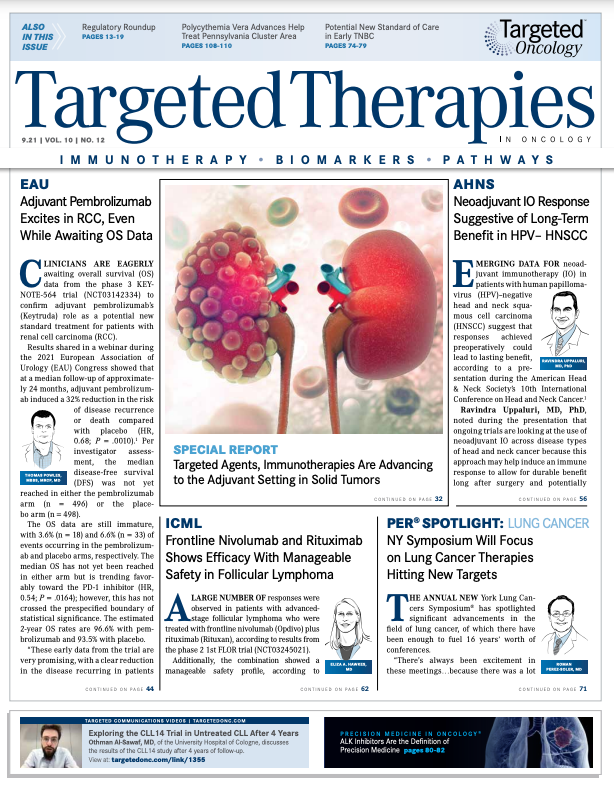NY Symposium Will Focus on Lung Cancer Therapies Hitting New Targets
In an interview prior to the NY Symposium, Perez-Soler, reviewed several areas of development in the lung cancer field that will be addressed during this year’s meeting.
Roman Perez-Soler, MD

The Annual New York Lung Cancers Symposium® has spotlighted significant advancements in the field of lung cancer, of which there have been enough to fuel 16 years’ worth of conferences.
“There’s always been excitement in these meetings…because there was a lot going on in lung cancer,” Roman Perez-Soler, MD, co-chair of the 16th Annual New York Lung Cancers Symposium® said.
This year is no exception, with recent approvals in targeted therapies for patients with lung cancers driving excitement for the field and complex discussions to be had over the treatment of patients with advanced disease states.
In an interview with Targeted Therapies in Oncology™ prior to the November meeting, Perez-Soler, who is Guttman Professor of Medicine and chairman of the Department of Oncology at Montefiore Medical Center and chief of the Division of Oncology at Albert Einstein College of Medicine in Bronx, New York, reviewed several areas of development in the lung cancer field that will be addressed during this year’s meeting.
KRAS Drives Excitement in Lung Cancer Field
The first exciting development he mentioned was the progress seen in blocking KRAS, which was previously an elusive target. Although the KRAS oncogene was discovered in 1983 and RAS was found to be one of the most commonly mutated gene families in cancers, no therapies were developed that could successfully target KRAS, so it began to be considered an “undruggable” target.1
However, a discovery was made for an allosteric binding pocket behind switch-II in the KRAS G12C pocket that would allow for compounds to bind KRAS G12C in the GDP-bound state, starting the more recent trend in development for KRAS inhibitors that are able to treat these mutations.
Since then, sotorasib (Lumakras; previously AMG 510) has been granted an accelerated approval by the FDA as the first KRAS inhibitor to treat adult patients with KRAS G12C–mutated locally advanced or metastatic non–small cell lung cancer (NSCLC) who have received at least 1 prior systemic therapy.2
“Finally now we have compounds that are significantly active against patients [who] have these mutations…So in the last couple of years, I think it’s the KRAS that is driving the interest and excitement [in the field]. Before that it was immunotherapy,” Perez-Soler commented.
In the CodeBreaK100 trial (NCT03600883), sotorasib demonstrated an objective response rate of 36% (95% CI, 28%-45%) in patients with locally advanced or metastatic NSCLC harboring a KRAS G12C mutation. The median duration of response was 10 months (range, 1.3+ to 11.1).
Perez-Soler commented that although response rates are not yet at the level seen with EGFR inhibitors, it is still a very good development and progress toward precision medicine for patients with lung cancer.
Narrowing in With EGFR Inhibition
As investigators continue to narrow in on actionable mutations, agents are being developed to specifically target individual disease characteristics. For example, although EGFR inhibitors have had a significant impact on the treatment of patients with NSCLC harboring EGFR mutations, lengthening the average survival of these patients, investigators found that this did not apply to all EGFR mutations, and thus all EGFR mutations cannot be treated alike.
Osimertinib (Tagrisso), a preferred first-line treatment option, may lead to overall survival of 36.8 months (95% CI, 34.5-41.8) in the treatment of patients with treatment-naive EGFR-mutant NSCLC, but this benefit is only seen in patients with exon 19 deletion or L858R mutations.3 Patients with EGFR exon 20 mutations tend to demonstrate lower survival rates with these standard EGFR inhibitors (progression-free survival, 3.0 months in EGFR exon 20 mutations vs 15.2 months in L858R mutations).4
EGFR exon 20 mutations are less common than exon 19 or 21 mutations and fewer agents exist to treat these rare mutations. However, several agents are in development to specifically target patients with these mutations.
Amivantamab (Rybrevant) was approved this year as the first targeted therapy for patients with NSCLC whose tumors have EGFR exon 20 insertion mutations being treated in the frontline setting.5
In the phase 1 CHRYSALIS trial (NCT02609776), amivantamab monotherapy led to an ORR of 40% (95% CI, 29%-51%), which included 3 complete responses, and the clinical benefit rate was 74% (95% CI, 63%-83%). The median DOR was 11.1 months and 63% of patients had a response lasting at least 6 months.
Developments in targeted therapies, including newer KRAS and EGFR inhibitors, will be addressed in the afternoon in the final session of the symposium (see AGENDA).
Addressing the Next Wave of Questions With Immunotherapy
As Perez-Soler noted, immunotherapy has been a significant source of excitement in the field of lung cancer over the past 10-plus years. “There’s no question that immunotherapy has represented the major event in lung cancer treatment in the last decade,” he said.
However, now that the efficacy in patients with NSCLC and small cell lung cancer has been definitively proven, investigators are hoping to answer further questions about the role that immune checkpoint inhibitors should play in the treatment paradigm.
“There’s really a need to better understand which patients will benefit the most from this approach,” Perez-Soler said. Investigators are looking for biomarkers to help identify patients who benefit more from immunotherapy and for mechanisms of resistance that prevent patients from benefiting from treatment.
He also noted that patients with lung cancer who are current or former smokers tend to have a more immunogenic disease and present with neoantigens, making them more sensitive to treatment with immunotherapy. However, the best use of immunotherapy for nonsmoking patients with actionable mutations is still unclear. “We always hoped that we could use immunotherapy for those who have targets when those [targeted therapy] compounds fail. And it turns out that immunotherapy doesn’t work as well,” Perez-Soler said.
Each of these points leads to avenues of further research into immunotherapy in the field of lung cancer. For example, many studies are looking to see if other treatments or modalities can be added to standard PD-1/PD-L1 immune checkpoint inhibition to either overcome potential mechanisms of resistance or make the approach beneficial for more patients with lung cancer.
The addition of chemotherapy to immunotherapy has led to improvements in responses and survival for patients with NSCLC. Recent results from the phase 3 EMPOWER-Lung 3 study (NCT03409614) showed that the addition of platinum-doublet chemotherapy to cemiplimab (Libtayo) in patients with advanced NSCLC led to a 9-month improvement in overall survival and a 29% reduction in the risk of death compared with chemotherapy alone (22 vs 13 months; HR, 0.71; 95% CI, 0.53-0.93; P = .014).6
Such research will continue to drive excitement for the potential of immunotherapy in the field of lung cancer.
Case Studies Fuel Discussion
Beyond presentations focusing on new treatment options in development, the symposium also will focus on case studies for a more real-world approach to treating patients seen in the clinic by participating oncologists and health care professionals. The symposium will include 2 tumor boards offering discussion on multiple approaches for a patient, as well as multiple discussions of challenging cases. Participants will hear from local physicians on cases and will discuss key aspects of treating patients with NSCLC.
Perez-Soler suggested that this tends to be one of the most enjoyable parts of the symposium as it allows for audience interaction, controversial discussions, and the opportunity to perhaps change practitioners’ minds on their standard treatment approaches.
This will be Perez-Soler’s last year as chair of the symposium. He noted that he is proud of how the meeting has grown over 16 years and how it has facilitated discussion and will continue to do so in the years ahead.
REFERENCES:
1. Moore AR, Rosenberg SC, McCormick F, Malek S. RAS-targeted therapies: is the undruggable drugged? Nat Rev Drug Discov. 2020;19(8):533- 552. doi:10.1038/s41573-020-0068-6
2. FDA grants accelerated approval to sotorasib for KRAS G12C mutated NSCLC. FDA. May 28, 2021. Accessed August 30, 2021. https://bit.ly/38slnUl
3. Ramalingam SS, Vansteenkiste J, Planchard D, et al; FLAURA Investigators. Overall Survival with Osimertinib in Untreated, EGFR-Mutated Advanced NSCLC. N Engl J Med. 2020;382(1):41-50. doi:10.1056/NEJMoa1913662
4. Tu HY, Ke EE, Yang JJ, et al. A comprehensive review of uncommon EGFR mutations in patients with non-small cell lung cancer. Lung Cancer. 2017;114:96-102. doi:10.1016/j.lungcan.2017.11.005
5. FDA approves first targeted therapy for subset of non-small cell lung cancer. News release. FDA. May 21, 2021. Accessed August 30, 2021. https://bit.ly/3fCjEyT
6. Phase 3 trial of Libtayo® (cemiplimab-rwlc) combined with chemotherapy stopped early due to significant improvement in overall survival in patients with first-line advanced non-small cell lung cancer. News release. Regeneron Pharmaceuticals, Inc. August 5, 2021. Accessed August 30, 2021. https://bit.ly/3Acasdh

Survivorship Care Promotes Evidence-Based Approaches for Quality of Life and Beyond
March 21st 2025Frank J. Penedo, PhD, explains the challenges of survivorship care for patients with cancer and how he implements programs to support patients’ emotional, physical, and practical needs.
Read More